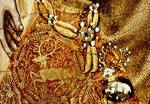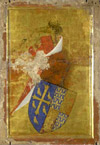portraits » The Wilton Diptych
The Wilton Diptych
The Wilton Diptych in the National Gallery takes its name from Wilton House, near Salisbury, Wiltshire, where it was housed between 1705 and 1929. The name of the artist and the place where it was made are unknown. It has been suggested that the painter came from Italy or Bohemia, but it is probable that the diptychdiptych - painting or other representation composed of two hinged leaves which close like a book was made on behalf of Richard II himself and that it was painted in England or northern France around the time of Richard's second marriage in 1396. Surviving panel paintings from northern Europe dating from the late fourteenth century are very rare.

The Wilton Diptych: interior (London, National Gallery). Egg tempera on oak 57 x 29.2 cm.
Larger image (67KB)
The diptych consists of two panels of Baltic oak. The gilded frames are carved out of the same wood. The iron hinges, which were originally also gilded, allowed it to be opened and closed like a book. It is painted on a prepared gold ground in egg temperaegg tempera - pigment mixed with egg. This allows the full purity of colour, especially the deep blue of ultamarine, to be exploited enhanced by translucent glazes, now partly lost. On the interior of the diptych Richard is presented to the Virgin Mary and the Christ Child by three saints. They are identified by their attributes: St John the Baptist holds the lamb, St Edward the Confessor a ring, and St Edmund, king and martyr, an arrow. Richard and the saints stand in an earthly landscape, while the Virgin and Child, who are surrounded by eleven angels, are in a paradise meadow strewn with flowers. Christ's halo is decorated in pointillépointillé - pattern formed of dots incised with a fine point with the crown of thorns and the nails prefiguring the crucifixion. One of the angels holds a staff with a pennon (banner), topped by an orb on which a tiny island is painted. The red cross of St George on the pennon also refers to Christ's resurrection.
Heraldry in the diptych
On the outside (exterior) of the diptych the heraldic decoration relates to Richard II. The king's arms on the panel behind the Virgin and Child consist of shield, cresting and mantle. This panel has sustained heavy use at one or another time. The fictive (invented) arms of Edward the Confessor are impaledimpaled - two coats of arms set side by side on a shield with the arms of England, an indication of date. Richard began to display his arms in this way only from 1395 onwards.
On the other panel is a white hart, Richard II's badge. Around its neck is a crown with a chain attached. The antlers stand out from the gold ground through the effect of light and shadow created in pointillé. The hart lies in a grassy meadow strewn with flowers and mingled with rosemary thought to be in remembrance of Richard's first wife, Anne of Bohemia. The green pigment has discoloured with age.

Detail from the The Wilton Diptych showing the white hart brooch and broomcod collar
Symbolism on the interior of the Diptych suggests that the painting dates to around the time of Richard's second marriage to Isabelle of France in 1396. Richard wears a brooch with his own badge of the white hart and a collar with the badge of broomcodsbroom - ('genêt') one of the heraldic badges of Charles VI of France in the form of branches, seed pods (broomcods), or broom flowers. Adopted by Richard II in 1396. of the French king, Charles VI. Richard's red mantle is depicted as if embroidered in gold with the two badges combined. The angels wear white hart brooches and broomcod collars.
Heraldry and badges in the treasure roll
A contemporary reported that in reality the French and English kings wore each other's badges when they met ceremonially to seal the twenty-eight year truce at Ardres (see Charles VI). In advance of the meeting Charles VI ordered a gold and jewelled broomcod collar for Richard, while Richard sent white hart brooches to France. Many objects in the inventory are decorated with these two badges. Richard also possessed several valuable white hart badges of gold, with enamel and jewels. One lay on a green terrace composed of emeralds and had pearls on the antlers. Broomcod collars given to Richard, to his uncle, Thomas of Woodstock, duke of Gloucester (see Lords Appellant), and to Isabelle, are listed in the treasure roll.

The arms of England impaled with the arms of Edward the Confessor. Exterior right wing of the Wilton Diptych.
Richard II's courtiers and favourites were quick to respond to the king's decision from around 1395 to impale his arms with the arms of Edward the Confessor. Six cups, a tripod and six basins decorated in this way are described in the inventory. Among them were gifts of the abbot of Westminster, the bishops of Ely, Exeter and Winchester, the earl of March and the countess of Hereford. On one of two cups given by William Wykeham, bishop of Winchester, the arms were combined with the English and French badges of a hart and broom. Other pieces depicted the saints most closely associated with Richard's personal devotion: St John the Baptist and St Edward. Sacred objects were not exempt from this specialised decoration. A gold lectern set with gems given to the king by his half brother, John Holland, as duke of Exeter (1397-9), for example, had images of both saints in pointillé, a hart and Richard II's motto, 'saunz departier'.

